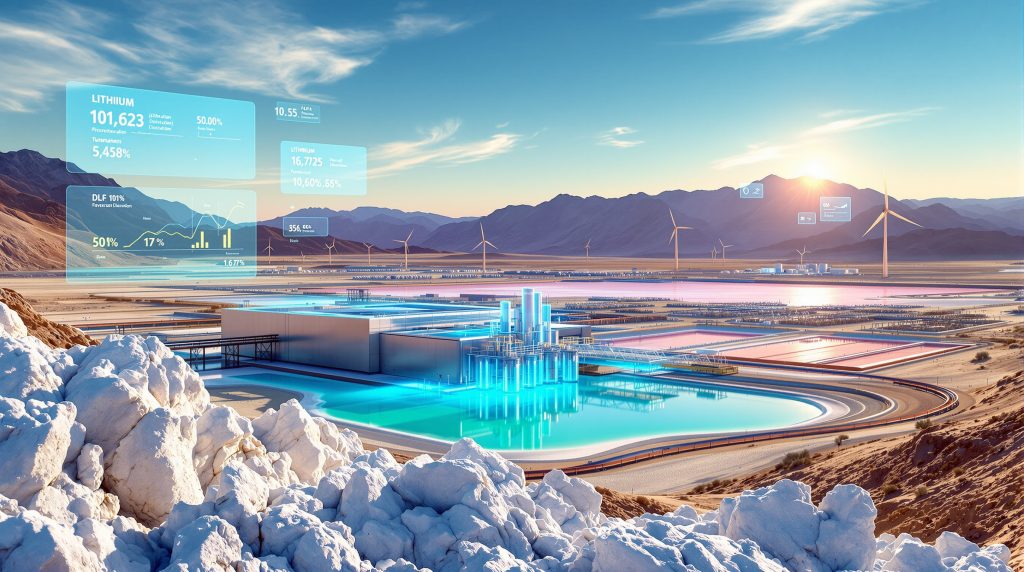Complex geological formations beneath the Earth's surface hold the key to modern energy transformation, yet the path from discovery to production remains one of the most challenging endeavours in natural resource development. While electric vehicle adoption accelerates and energy storage demands surge globally, the technical complexities of extracting lithium compounds from diverse geological environments continue to test even the most experienced project developers.
The intricate dance between geological assessment, regulatory compliance, and market dynamics shapes every aspect of lithium project development, creating a multi-decade journey that requires sophisticated planning and substantial capital allocation. Furthermore, understanding these interconnected systems becomes essential for investors, operators, and stakeholders navigating this rapidly evolving sector, particularly with lithium industry innovations transforming traditional development approaches.
What Defines Successful Lithium Project Development in Today's Market?
The foundation of any successful lithium venture begins with robust resource classification and strategic project design. Current market conditions demonstrate the critical importance of comprehensive feasibility planning, with recent project announcements highlighting the complex relationship between resource confidence and development viability.
Power Minerals' Incahuasi Lithium Project exemplifies modern development approaches, targeting 5,000 tonnes per annum of high-purity lithium carbonate production based on a JORC Mineral Resource Estimate of 235 kilotonnes of lithium carbonate equivalent. This scale represents the careful balance between resource utilisation and market positioning that characterises contemporary lithium project development.
Critical Success Metrics Beyond Resource Size
Resource classification standards form the backbone of project credibility and financing potential. The JORC Code and NI 43-101 frameworks provide standardised methodologies for resource reporting, with each category carrying distinct implications for investment risk and development timelines.
Key Performance Indicators for Project Viability:
• Resource Confidence Levels: Measured resources command premium valuations compared to inferred categories
• Capital Efficiency Ratios: Production capacity per dollar of invested capital varies significantly by deposit type
• Environmental Compliance Frameworks: Proactive environmental planning prevents costly development delays
• Community Engagement Protocols: Early stakeholder consultation reduces permitting risks
The distinction between resource categories directly impacts financing costs, with measured and indicated resources typically qualifying for lower-cost project financing compared to ventures relying heavily on inferred resource estimates. This classification system influences everything from initial feasibility assessments to final investment decisions.
Resource Classification Standards and Investment Implications
JORC-compliant reporting provides Australian and international investors with standardised metrics for project comparison. The three-tier classification system of measured, indicated, and inferred resources reflects increasing levels of geological confidence, with each category supporting different phases of project development and financing.
Resource confidence levels directly correlate with financing accessibility, as measured resources typically qualify for development-stage funding while inferred resources may only support exploration-phase investment.
Recent market developments underscore the importance of resource classification in project advancement. The strengthening lithium price environment, with lithium carbonate spot prices up approximately 30% year-to-date and spodumene concentrate benchmarks rising 35% over the same period, has renewed investor focus on projects with well-defined resource bases.
How Do Geographic Factors Shape Development Strategies?
Geographic positioning fundamentally determines extraction methodologies, infrastructure requirements, and regulatory pathways for lithium projects. The distinction between brine-based operations in South American salt flats and hard rock spodumene extraction in Australian pegmatites creates entirely different operational frameworks and development timelines.
However, Argentina lithium brines represent the established South American lithium triangle advantage of proven extraction expertise and existing regional infrastructure. This geographic positioning provides access to specialised contractors, established supply chains, and regulatory frameworks optimised for lithium brine operations.
Brine vs Hard Rock: Operational Trade-offs Analysis
The fundamental differences between lithium brine extraction and hard rock lithium extraction create distinct development pathways with varying risk profiles and capital requirements.
Comparative Development Characteristics:
| Deposit Type | Primary Advantages | Key Challenges | Infrastructure Needs |
|---|---|---|---|
| South American Brines | Lower processing costs, established expertise | Water rights complexity, evaporation dependency | Solar evaporation ponds, water management |
| Australian Hard Rock | Processing flexibility, weather independence | Higher energy requirements, complex metallurgy | Power infrastructure, processing facilities |
| North American Clays | Domestic supply security, processing innovation | Unproven commercial scale, higher costs | Advanced processing technology, skilled labour |
Brine operations typically require extensive land areas for evaporation ponds and sophisticated water management systems, while hard rock projects demand substantial electrical power infrastructure and complex mineral processing facilities. These geographic realities influence everything from initial capital expenditure to ongoing operational costs.
Infrastructure Requirements by Deposit Type
The infrastructure demands of lithium extraction vary dramatically based on geological characteristics and geographic location. Brine operations require extensive water access and management systems, with some projects utilising groundwater pumping capacities exceeding millions of litres annually.
Essential Infrastructure Components:
• Power Grid Connectivity: Hard rock operations may require 50-100 MW of continuous power capacity
• Water Management Systems: Brine operations need sophisticated water rights and recycling capabilities
• Transportation Networks: Remote locations often require dedicated road or rail connections
• Processing Facilities: Chemical processing plants require specialised construction and permitting
The Incahuasi project's positioning in Argentina's established lithium-producing region provides access to existing infrastructure networks and experienced contractor pools, potentially reducing both development timelines and capital requirements compared to greenfield locations without existing lithium industry presence.
Which Regulatory Pathways Accelerate Project Timelines?
Regulatory frameworks increasingly recognise lithium's strategic importance, with governments implementing fast-track permitting processes for critical mineral projects. These streamlined pathways can significantly reduce development timelines while maintaining environmental and social safeguards.
In addition, the designation of critical minerals status provides tangible benefits for project developers, including priority processing for environmental assessments and streamlined inter-agency coordination. Recent developments include the United States declaring silver a critical mineral, highlighting the expanding recognition of strategic metal importance.
Fast-Track Permitting Programs and Their Impact
FAST-41 designation in the United States exemplifies how regulatory reform can accelerate major infrastructure projects. This coordinated permitting process provides single points of contact for complex multi-agency approvals, potentially reducing administrative delays that traditionally extend project timelines.
Critical Minerals Classification Benefits:
• Expedited Review Processes: Priority scheduling for environmental impact assessments
• Coordinated Agency Consultation: Reduced bureaucratic delays through centralised management
• Funding Priority Access: Preferential consideration for government financing programmes
• Strategic Partnership Opportunities: Enhanced access to international investment partnerships
The growing recognition of lithium's strategic importance has attracted international attention, with European Union initiatives specifically targeting Australian critical mineral investments. For instance, global lithium investments create additional financing opportunities and regulatory support for qualifying projects.
Environmental Assessment Integration Strategies
Proactive environmental planning during early project phases prevents costly delays during advanced development stages. Successful operators integrate environmental considerations into initial project design rather than treating compliance as a separate, sequential process.
Early-stage water rights acquisition, indigenous consultation protocols, and baseline environmental studies conducted during exploration phases create foundation for streamlined permitting processes. This integrated approach contrasts with traditional sequential development models that often encounter regulatory bottlenecks during construction phases.
Proactive environmental planning during exploration phases can prevent permitting delays that traditionally add years to project development timelines.
What Financial Models Drive Project Viability Decisions?
Financial modelling for lithium projects must account for extreme commodity price volatility, extended development timelines, and substantial upfront capital requirements. Current market conditions demonstrate how price movements can fundamentally alter project economics and investment priorities.
The recent strength in lithium pricing provides compelling support for project advancement decisions. Managing Director Mena Habib noted that Power Minerals remains committed to advancing the Incahuasi project as a future long-term producer, with the conceptual development study providing a logical and technically feasible measure of development viability.
Capital Allocation Across Development Phases
Lithium project development requires careful capital allocation across multiple phases, with the majority of expenditure concentrated during construction and commissioning phases.
Typical Capital Distribution Patterns:
| Development Phase | Percentage of Total Capex | Key Activities | Risk Characteristics |
|---|---|---|---|
| Exploration & Resource Definition | 5-10% | Drilling, resource modelling, initial studies | High technical risk, lower capital exposure |
| Feasibility Studies & Engineering | 10-15% | Detailed engineering, permitting, financing | Moderate risk, critical decision points |
| Permitting & Regulatory | 5-10% | Environmental approvals, consultation | Low technical risk, timeline uncertainty |
| Construction & Commissioning | 70-80% | Plant construction, equipment installation | Lower technical risk, highest capital exposure |
This capital allocation pattern creates distinct risk profiles across development phases, with early-stage activities carrying higher technical risks but lower capital exposure, while construction phases involve substantial financial commitments with more predictable technical outcomes.
Revenue Forecasting in Volatile Commodity Markets
Lithium price forecasting presents unique challenges due to the metal's relatively short commercial history and rapidly evolving demand patterns. Current market dynamics illustrate these complexities, with multiple factors contributing to recent price strength.
Investment bank analyst commentary, leadership statements from major producers, and operational disruptions at significant mining operations have combined to support current pricing levels. Furthermore, the ongoing issues at CATL's Jianxiawo mine in China exemplify how individual facility disruptions can influence global pricing dynamics.
Revenue Modelling Considerations:
• Long-term Contract Structures: Offtake agreements provide price stability but may limit upside participation
• Product Specification Premiums: High-purity lithium carbonate commands premium pricing over technical grade
• Market Timing Factors: Production ramp-up timing relative to demand cycles affects revenue realisation
• Currency Exchange Impact: International projects face additional currency risk considerations
The Incahuasi project's target production of high-purity lithium carbonate positions the venture to capture premium pricing relative to lower-grade lithium products, though this specification also requires more sophisticated processing capabilities and quality control systems.
How Do Processing Technologies Influence Development Decisions?
Processing technology selection fundamentally shapes project economics, environmental impact, and operational complexity. The emergence of Direct Lithium Extraction (DLE) technologies promises to revolutionise brine-based operations through improved recovery rates and reduced environmental footprints.
Traditional evaporation pond systems require extensive land areas and multi-year processing cycles, while DLE technologies can potentially reduce water consumption by up to 90% while accelerating production timelines. These technological advances create new possibilities for projects previously considered economically marginal.
Direct Lithium Extraction (DLE) vs Conventional Methods
DLE technologies represent a paradigm shift from traditional evaporation-based brine processing, offering potential advantages in recovery efficiency, environmental impact, and production flexibility.
Processing Technology Comparison:
| Method | Recovery Rates | Water Usage | Production Timeline | Capital Requirements |
|---|---|---|---|---|
| Traditional Evaporation | 30-70% | High consumption | 12-18 months per batch | Lower initial capex |
| Direct Lithium Extraction | 80-95% | Up to 90% reduction | Continuous processing | Higher technology investment |
| Hybrid Approaches | 70-85% | Moderate consumption | 6-12 months | Balanced capital requirements |
Consequently, the Incahuasi project's joint venture with Summit Nanotech suggests potential incorporation of advanced extraction technologies, though specific processing methodologies have not been disclosed in publicly available information.
Modular Processing Facility Design Advantages
Modular processing approaches allow project developers to scale production capacity incrementally, reducing initial capital requirements while providing flexibility to respond to market conditions and operational experience.
This scalable design philosophy contrasts with traditional approaches that require full-scale construction before production commencement. Modular systems enable phased production ramp-ups that can generate early cash flows to support subsequent expansion phases.
Modular Design Benefits:
• Reduced Initial Capital: Smaller upfront investment enables project financing for emerging developers
• Operational Learning: Early production provides operational experience before full-scale commitment
• Market Responsiveness: Production scaling can respond to demand fluctuations and price cycles
• Technology Integration: Newer processing technologies can be incorporated in expansion phases
What Risk Management Frameworks Protect Development Investments?
Lithium project development involves multiple risk categories requiring sophisticated mitigation strategies. Technical, market, regulatory, and operational risks each demand specific management approaches to protect substantial development investments.
The extended development timelines typical of lithium project development create additional exposure to changing market conditions, regulatory environments, and technological advances. Successful risk management requires comprehensive frameworks addressing both predictable and emerging risk factors.
Technical Risk Mitigation Strategies
Technical risk reduction follows established protocols that validate processing assumptions through progressive testing phases before committing to full-scale construction.
Critical Technical De-risking Milestones:
• Bench-scale Testing Completion: Laboratory-scale process validation and optimisation
• Pilot Plant Operation Validation: Semi-commercial scale testing with actual ore samples
• Commercial-scale Process Confirmation: Full-scale demonstration before project construction
• Metallurgical Testwork Programmes: Comprehensive analysis of ore variability and processing responses
The progression from bench-scale through pilot-scale to commercial demonstration provides increasing confidence in technical assumptions while identifying potential operational challenges before major capital commitment.
Market and Regulatory Risk Hedging
Market volatility protection requires sophisticated financial instruments and strategic partnerships that provide price stability during development phases and early production periods.
Risk Mitigation Instruments:
| Risk Category | Mitigation Tools | Implementation Timing | Effectiveness |
|---|---|---|---|
| Commodity Price | Forward sales, options, futures | Pre-construction to production | High for price floors |
| Political/Regulatory | Insurance, bilateral treaties | Early development | Moderate to high |
| Currency Exchange | Currency hedging, local financing | Throughout development | High for known exposures |
| Operational | Insurance, technical guarantees | Construction and operation | Variable by coverage |
Political risk insurance becomes particularly important for projects in emerging markets, providing protection against regulatory changes, currency inconvertibility, and expropriation risks that could threaten project viability.
Which Emerging Technologies Are Reshaping Development Approaches?
Advanced extraction and processing innovations continue reshaping lithium project development possibilities. Selective leaching technologies, membrane separation systems, and integrated processing solutions offer improved efficiency and reduced environmental impact compared to conventional approaches.
Digital integration and process optimisation through IoT sensors, predictive maintenance systems, and real-time monitoring capabilities can reduce operational downtime by 15-25% while improving process efficiency and product quality consistency. These developments align with broader mining industry innovation trends transforming traditional operational approaches.
Advanced Extraction and Processing Innovations
Selective extraction technologies enable more precise lithium recovery while minimising extraction of unwanted minerals and reducing processing complexity. These innovations particularly benefit projects with complex brine chemistry or lower-grade resources.
Membrane separation systems provide continuous processing capabilities that eliminate traditional batch processing limitations while reducing chemical consumption and waste generation. These technologies align with increasing environmental requirements and social licensing expectations.
Emerging Technology Applications:
• Selective Ion Exchange: Targeted lithium extraction from complex brine solutions
• Membrane Filtration: Continuous separation processes with reduced chemical requirements
• Electrochemical Processing: Direct conversion to battery-grade compounds
• Integrated Processing: Combined extraction and conversion in single facilities
Digital Integration and Process Optimisation
Real-time monitoring systems and predictive analytics enable proactive maintenance scheduling and process optimisation that improves operational efficiency while reducing downtime costs.
IoT sensor networks provide continuous data streams on equipment performance, process parameters, and environmental conditions, enabling rapid response to operational variations and preventing costly production interruptions.
Digital monitoring and predictive maintenance systems can reduce operational downtime by 15-25% while improving process consistency and product quality.
How Do Supply Chain Considerations Influence Project Planning?
Supply chain resilience and downstream integration opportunities increasingly influence lithium project development strategies. The concentration of lithium processing capacity in specific geographic regions creates both opportunities and vulnerabilities for project developers.
Strategic partnerships with battery manufacturers and downstream processors can provide long-term offtake security while potentially enabling premium pricing for high-specification products. These relationships also facilitate technology transfer and operational expertise sharing.
Downstream Integration Opportunities
Vertical integration toward battery-grade compound production enables project developers to capture additional value margins while providing greater control over product quality and customer relationships.
The development of battery-grade lithium hydroxide and carbonate production capabilities requires sophisticated chemical processing expertise and quality control systems, but can provide significant economic advantages over concentrate sales to third-party processors.
Integration Strategy Considerations:
| Integration Level | Value Capture | Capital Requirements | Technical Complexity | Market Access |
|---|---|---|---|---|
| Concentrate Production | Base value | Lower | Moderate | Commodity markets |
| Battery-grade Compounds | Premium value | Higher | High | Direct customer relationships |
| Cathode Material Production | Maximum value | Highest | Very high | Battery manufacturer partnerships |
Geographic Diversification and Supply Security
Regional supply chain concentration creates both opportunities and risks for lithium project development. The dominance of Chinese processing capacity provides established market access but also creates supply chain concentration risks for consuming countries.
Government initiatives promoting domestic lithium processing capacity create opportunities for projects offering supply chain diversification benefits. Critical mineral designation and supply security considerations increasingly influence project prioritisation and financing availability.
Supply Chain Risk Factors:
• Processing Concentration: Limited number of qualified processing facilities globally
• Transportation Bottlenecks: Port access and shipping capacity constraints
• Trade Policy Exposure: Tariff and trade restriction impacts on project economics
• Technology Access: Dependence on proprietary processing technologies
What Does the Future Hold for Lithium Project Development?
Demand projections for lithium continue reflecting rapid electric vehicle adoption and expanding energy storage requirements. Industry forecasts suggest annual demand growth of 20-25% through 2030, though supply response and price volatility create ongoing uncertainty for project developers.
The expanding recognition of lithium's strategic importance drives government support for domestic production capabilities while environmental and social governance requirements increasingly influence project approval processes and financing availability.
Demand Projections and Capacity Planning
Electric vehicle adoption trajectories and energy storage market expansion create long-term demand fundamentals supporting lithium project development, though short-term price volatility continues challenging project financing and development timing decisions.
Battery technology evolution toward higher energy density and improved performance characteristics maintains strong lithium demand growth prospects while potentially altering specific product requirements and quality specifications.
Market Growth Drivers:
• Electric Vehicle Penetration: Expanding global EV adoption across all vehicle categories
• Grid-scale Energy Storage: Renewable energy integration driving stationary storage demand
• Consumer Electronics: Continued growth in portable device applications
• Industrial Applications: Emerging uses in specialised industrial processes
Sustainability Standards and ESG Integration
Environmental, social, and governance considerations increasingly influence project approval processes, financing availability, and customer acceptance. Carbon footprint reduction, water stewardship, and community engagement become competitive advantages rather than merely compliance requirements.
Projects demonstrating superior ESG performance gain preferential access to financing, customer relationships, and regulatory approvals. This trend particularly benefits projects incorporating advanced processing technologies and comprehensive stakeholder engagement programmes.
ESG Integration Requirements:
• Carbon Footprint Reduction: Renewable energy integration and process efficiency improvements
• Water Stewardship: Comprehensive water management and conservation programmes
• Community Partnerships: Indigenous consultation and local economic participation
• Biodiversity Protection: Habitat preservation and restoration commitments
The evolution of lithium project development reflects broader trends toward sustainable resource extraction, technological innovation, and strategic supply chain positioning. Projects successfully integrating these considerations while maintaining economic viability will likely achieve competitive advantages in securing financing, regulatory approvals, and customer relationships. However, as highlighted by comprehensive analysis from Rio Tinto's Rincon operation, successful development requires careful consideration of environmental and social factors alongside technical feasibility.
Disclaimer: This analysis contains forward-looking statements and market projections that involve inherent uncertainties and risks. Lithium market conditions, technology development, and regulatory environments can change rapidly, potentially affecting project viability and investment outcomes. Readers should conduct independent research and seek professional advice before making investment decisions related to lithium projects or companies.
Ready to Position Yourself Ahead of the Next Major Lithium Discovery?
Discovery Alert's proprietary Discovery IQ model delivers instant notifications of significant ASX mineral discoveries, transforming complex geological data into actionable investment insights for both short-term traders and long-term investors. Explore how historic discoveries can generate substantial market returns and begin your 30-day free trial today to secure your competitive advantage in this rapidly evolving sector.




